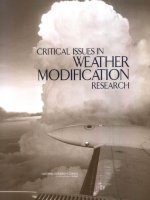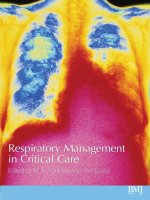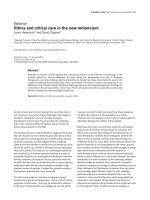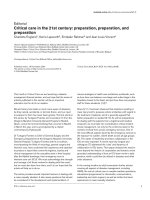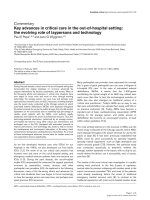2012 critical care in neurology
Bạn đang xem bản rút gọn của tài liệu. Xem và tải ngay bản đầy đủ của tài liệu tại đây (673.08 KB, 119 trang )
More books at www.FlyingPublisher.com
goo.gl/QOUDJ
the
Flying Publisher Guide to
Critical Care
Kitchener, Hashem, Wahba,
Khalaf, Zarif, Mansoor
Flying PublisheR
2012
#7
in Neurology
Kitchener – Hashem – Wahba – Khalaf – Zarif – Mansoor
Critical Care in Neurology
Nabil Kitchener
Saher Hashem
Mervat Wahba
Magdy Khalaf
Bassem Zarif
Simin Mansoor
The Flying Publisher Guide to
Critical Care in Neurology
2012 Edition
Flying Publisher
4
|
Correspondence:
Disclaimer
Neurocritical care is an ever-changing field. The publishers and
author of The Flying Publisher Guide to Critical Care in
Neurology have made every effort to provide information that is
accurate and complete as of the date of publication. However, in
view of the rapid changes occurring in medical science, as well
as the possibility of human error, this site may contain technical
inaccuracies, typographical or other errors. It is the
responsibility of the reading physician who must rely on
experience and knowledge about the patient to determine the
best treatment and care pathway. The information contained
herein is provided “as is”, without warranty of any kind. The
contributors to this book, including Flying Publisher & Kamps,
disclaim responsibility for any errors or omissions or for results
obtained from the use of information contained herein.
This work is protected by copyright both as a whole and in part.
Copy editing: Nilly Nagy and Rob Camp
© 2012 by Flying Publisher & Kamps / Design: Attilio Baghino
ISBN: 978-3-942687-07-2
|
5
Prologue
Neurointensive care is a relatively new field that has developed
as a subspecialty of critical care and neurology. The goal of
neurointensive care, and the neurointensivist, is to treat and
prevent primary and secondary brain (or other nervous system)
injury. Inherent in this goal are the monitoring tools unique to
the neurointensive care unit, including the most basic but
perhaps the most important tool, the neurologic examination. In
the era of the subspecialty of critical care neurology, the
neurologist is working now as an aggressive interventionalist
who manages life-threatening disorders of the nervous system.
The neurointensivist’s role is to help follow the neurologic status
and treat the patient while integrating his/her knowledge of
other organ systems and expertise in critical care, to provide the
most comprehensive care possible for the patient.
Critical care neurology is practiced in emergency rooms, in
consultations in general medical and surgical intensive care
units, in intermediary care units such as stroke units, and in
specialized neurointensive care units where patients are
frequently on life-support systems involving ventilators,
intravascular lines, and monitoring and treatment devices. Data
has shown that care provided by clinicians specializing in
neurologic injury, and within dedicated neurointensive care
units, improves patient functional outcome, and reduces
hospital mortality, length of stay and resource utilization.
This book emphasizes the clinical and practical aspects of
management in the neurointensive care unit.
This book is written, mainly, for the neurologist working in, or
directing, a specialized neurointensive care unit
(neurointensivists), as well as other specialists including stroke
neurologists, neurosurgeons, pulmonary/critical care specialists,
anesthesiologists, nurse practitioners, critical care registered
5
6
|
nurses, and therapists all working together towards improved
neurologic recovery.
We hope this book can provide a new addition to the emerging
literature of critical care neurology, and heighten the
recognition by general medical and surgical intensivists of the
importance and complexities of nervous system dysfunction in
critically ill and injured patients.
The Editors
Nabil Kitchener, Saher Hashem, Mervat Wahba
Egypt, USA, January 2012
7
|
Editors
Authors
Nabil Kitchener, MD, PhD
Professor of Neurology, GOTHI,
Egypt
President of Egyptian CerebroCardio-Vascular Association
(ECCVA) and Board Director of
World Stroke Organization
(WSO)
www.ECCVA.com
Magdy Khalaf, MD
Consultant Neurologist and
Chairman of Neurocritical Care
Unit
GOTHI, Egypt
Saher Hashem, MD
Professor and Chairman of
Neurology and Neurocritical
Department
Cairo University, Egypt
Simin Mansoor, MD
Department of Neurology
University of Tennessee Health
Sciences Center, UTHSC, USA
Mervat Wahba, MD, FCCP
Assistant Professor of Neurology
Department of Neurology
University of Tennessee Health
Sciences Center, UTHSC, USA
Bassem Zarif, MD
Lecturer of Cardiology
National Heart Institute, GOTHI,
Egypt
8
|
|
9
Table of Contents
1. Assessment of Patients in Neurological Emergency............... 13
History ...................................................................................... 15
Physical Exam .......................................................................... 16
1. Mental status ................................................................... 16
2. Cranial nerve (CN) exam ................................................ 16
3. Motor exam ..................................................................... 18
4. Reflexes ............................................................................ 18
5. Sensory exam .................................................................. 18
6. Coordination and balance ............................................. 18
7. Neuroanatomical localization ....................................... 19
Conclusions .............................................................................. 20
2. How to Approach an Unconscious Patient .............................. 21
Diagnosis .................................................................................. 23
Basic assessments ............................................................... 24
General Care of the Comatose Patient .................................. 27
Permanent Vegetative State .................................................. 27
Diagnosis .............................................................................. 29
Management ....................................................................... 29
Locked-in Syndrome ............................................................... 30
Brain Death .............................................................................. 31
3. Documentation and Scores ........................................................ 32
Scoring and Documentation .................................................. 34
Delirium .................................................................................... 38
10
|
4. Brain Injuries ............................................................................... 39
Types of Brain Injuries ........................................................... 39
Primary brain injuries ....................................................... 39
Secondary brain injuries ................................................... 42
Management of Special Issues ............................................... 44
Traumatic brain injury ...................................................... 44
Acute stroke ........................................................................ 45
Status epilepticus (SE) ........................................................ 46
Neuromuscular emergencies ............................................ 47
Management of subarachnoid hemorrhage .................... 50
5. Basic Hemodynamic Monitoring of Neurocritical Patients ... 53
6. Neurocritical Monitoring........................................................... 59
Neuro-Specific Monitoring .................................................... 59
Clinical Assessment ................................................................. 60
The Glasgow Coma Scale .................................................... 60
Pupillary response .............................................................. 60
Invasive Monitoring ................................................................ 61
Measuring ICP ..................................................................... 62
Indications for ICP monitoring ......................................... 62
Intracranial Pressure Waveforms and Analysis.............. 63
Jugular Venous Oximetry (SjvO2)...................................... 67
Brain Tissue Oximetry ....................................................... 69
Noninvasive Monitoring......................................................... 71
Continuous measures of CBF by Transcranial Doppler.. 71
Near Infrared Spectroscopy .............................................. 73
Electrophysiological Monitoring ........................................... 73
Application of the EEG in the ICU: .................................... 76
Multimodal Monitoring .......................................................... 77
Conclusions .............................................................................. 77
7. Cerebral Edema ........................................................................... 79
Types of Cerebral Edema ........................................................ 81
Management of Cerebral Edema ........................................... 82
|
11
8. General Neurological Treatment Strategies ............................ 84
Swallowing Disturbances ....................................................... 85
Respiratory Management in Neurocritical Care ................. 86
Infection Control in Neurocritical Care................................ 89
Pain Relief and Sedation ......................................................... 90
Bedside approach to the agitated patient ....................... 91
Role of Rehabilitation ............................................................. 92
Diagnostic Findings in Cerebral Death ................................. 93
Conclusion ................................................................................ 96
9. Medical Diseases and Metabolic Encephalopathies ................ 97
Examination of the Encephalopathic Patient ...................... 98
General Pathophysiology ....................................................... 99
Hepatic Encephalopathy ........................................................ 99
Complications of hepatic encephalopathy (HE) ........... 100
Treatment of hepatic encephalopathy .......................... 102
Renal Encephalopathies ....................................................... 102
Fluid and Electrolyte Imbalance.......................................... 104
Osmolarity disorders ........................................................ 104
Encephalopathy in Diabetic Patients .................................. 106
Hypoxic Ischemic Encephalopathy (HIE) ........................... 107
Septic Encephalopathy ......................................................... 108
Drug-induced Encephalopathies ......................................... 108
10. References.................................................................................. 109
12
|
Assessment of Patients in Neurological Emergency
|
13
1. Assessment of Patients in
Neurological Emergency
Nabil Kitchener, Saher Hashem
Care in specialized intensive care units (ICUs) is generally of
higher quality than in general care units. Neurocritical care
focuses on the care of critically ill patients with primary or
secondary neurosurgical and neurological problems and was
initially developed to manage postoperative neurosurgical
patients. It expanded thereafter to the management of patients
with traumatic brain injury (TBI), intracranial hemorrhage and
complications of subarachnoid hemorrhage; including
vasospasm, elevated intracranial pressure (ICP) and the
cardiopulmonary complications of brain injury.
Neurocritical care units have developed to coordinate the
management of critically ill neurological patients in a single
specialized unit, which includes many clinical domains. Care is
provided by a multidisciplinary team trained to recognize and
deal with the unique aspects of the neurological disease
processes, as several treatable neurological disorders are
characterized by imminent risk of severe and irreversible
neurological injury or death if treatment is delayed.
Some diseases need immediate action, so admission to the NICU
is the best solution when there is:
14
| Critical Care in Neurology
1)
2)
3)
4)
5)
6)
Impaired level of consciousness.
Progressive respiratory impairment or the need for
mechanical ventilation in a neurological patient.
Status epilepticus or prolonged seizures.
Clinical or Computed Tomographic (CT) evidence of raised
Intracranial Pressure (ICP), whatever the cause (space
occupying lesion, cerebral edema or hemorrhagic
conversion of a cerebral infarct, intracerebral hemorrhage,
etc.)
Need for monitoring (for example, level of consciousness,
ICP, continuous electroencephalography (cEEG)), and
Need for specific treatments (Baldwin 2010) (e.g.,
neurosurgery, intravenous or arterial thrombolysis).
In the Neurocritical Care unit, patients with primary
neurological diseases such as myasthenia gravis, Guillain-Barré
syndrome, status epilepticus, and stroke have a better outcome
than those patients with secondary neurological diseases. So, we
can conclude that these specialized units have greater
experience in the anticipation, early recognition, and
management of potentially fatal complications.
Early identification of patients at risk of life threatening
neurological illness in order to manage them properly and to
prevent further deterioration is the role of general assessment of
new patients in a neurological emergency. History taking and a
rapid neurological assessment of a specific patient in specialized
neurocritical care units helps answer the question ‘how sick is
this patient?’.
The neurologic screening examination in the emergency
settings focuses primarily on identifying acute, potentially lifethreatening processes, and secondarily on identifying disorders
that require other opinions, of other specialists.
The importance of urgent neurologic assessment comes from
recent advances in the management of neurologic disorders
needing timely intervention like thrombolysis in acute ischemic
Assessment of Patients in Neurological Emergency
|
15
stroke, anticonvulsants for nonconvulsive and subtle generalized
status epilepticus, and plasmapheresis for Guillain-Barré, etc.
It is obvious that interventions can be time-sensitive and can
significantly reduce morbidity and mortality.
A comprehensive neurologic screening assessment can be
accomplished within minutes if performed in an organized and
systematic manner (Goldberg 1987). Neurologic screening
assessment includes six major components of the neurologic
exam, namely:
1) Mental status
2) Cranial nerve exam
3) Motor exam
4) Reflexes
5) Sensory exam
6) Evaluation of coordination and balance.
Based on the chief findings of the screening assessment,
further evaluation or investigations can be then decided upon.
History
A careful history is the first step to successful diagnosis, and
then intervention. Careful history provides clues to the
pathology of the patient’s condition, and may help direct the
diagnostic workup. For example, an alert patient with a
headache associated with neck pain that started after a car
accident might help direct the examination and radiographic
imaging to focus on cervical spine injury or neck vessels (carotid
or vertebral artery) dissection, while the same patient not in a
car accident may direct your attention to a spontaneous
subarachnoid hemorrhage.
The history begins with a definition of the patient’s complaint,
but aiming at determining key points: time and mode of onset,
mode of progression, associated symptoms, and a prior history
of similar conditions. Dramatic or acute onset of neurologic
events suggests a vascular insult and mandates immediate
attention and intervention.
16
| Critical Care in Neurology
Physical Exam
1. Mental status
Usually we start neurologic examination by assessing the
patient’s mental status (Strub 2000).
A full mental status exam is not necessary in the patient who is
conscious, awake, oriented, and conversant; on the contrary it
must be fully investigated in patients with altered mental status.
Sometimes, we can find no change in mental status; at that
point careful consideration should be given to concerns of
family.
A systematic approach to the assessment of mental status is
helpful in detecting acute as well as any chronic disease, such as
delirious state in a demented patient (Lewis 1995). The CAM
(confusion assessment method) score was developed to assist in
diagnosing delirium in different contexts. CAM assesses four
components: acute onset, inattention, disorganized thinking or
an altered level of consciousness with a fluctuating course. A
‘Mini-Mental Status’ test can also be used but usually is reserved
for patients with suspected cognitive dysfunction as it evaluates
five domains – orientation, registration, attention, recall, and
language (Strub 2000).
2. Cranial nerve (CN) exam
Cranial Nerves II - VIII function testing are of utmost value in the
neurologic assessment in an emergency setting (Monkhouse
2006).
Cranial Nerves II – Optic nerve assessment involves visual
acuity and fields, along with a fundus exam and a swinging
flashlight test. Visual field exam using the confrontation method
is rapid and reliable. Visual loss in one eye suggests a nerve
lesion, i.e., in front of the chiasm; bitemporal hemianopsia
suggests a lesion at the optic chiasm; a quadrant deficit suggests
a lesion in the optic tracts; bilateral visual loss suggests cortical
disease.
Assessment of Patients in Neurological Emergency
|
17
Assessment of the optic disc, retinal arteries, and retinal veins
can be done by a fundus exam, to discover papilledema, flame
hemorrhages or sheathing.
Cranial Nerves III, IV, VI – CN III innervates the extraocular
muscles for primarily adduction and vertical gaze. CN III
function is tested in conjunction with IV, which aids in internal
depression via the superior oblique, and VI, which controls
abduction via the lateral rectus. Extraocular muscle function is
tested for diplopia, which requires binocular vision and thus will
resolve when one eye is occluded. Marked nystagmus on lateral
gaze or any nystagmus on vertical gaze is abnormal; vertical
nystagmus is seen in brainstem lesions or intoxication, while
pendular nystagmus is generally a congenital condition.
The pupillary light reflex is mediated via the parasympathetic
nerve fibers running on the outside of CN III. In the swinging
flashlight test a light is shone from one eye to the other; when
the light is shone directly into a normal eye, both eyes constrict
via the direct and the consensual light response.
Pupillary size must be documented. Asymmetry in pupils of less
than 1 mm is not significant. Significant difference in pupil size
suggests nerve compression due to aneurysms or due to cerebral
herniation, in patients with altered mental status.
Bilateral pupillary dilation is seen with prolonged anoxia or
due to drugs (anticholinergics), while bilateral pupillary
constriction is seen with pontine hemorrhage or as the result of
drugs (e.g., opiates, clonidine).
Cranial Nerve V – Individual branch testing of the trigeminal
nerve is unnecessary, as central nervous system lesions affecting
CN V usually involve all three branches.
Cranial Nerve VII – The facial nerve innervates motor
function to the face, and sensory function to the ear canal, as
well as to the anterior two-thirds of the tongue. Central lesions
cause contralateral weakness of the face muscles below the eyes.
Cranial Nerve VIII – The acoustic nerve has a vestibular and a
cochlear component. An easy screening test for hearing defects
is accomplished by speaking in graded volumes to the patient.
18
| Critical Care in Neurology
When vestibular nerve defects are suspected, patients are
assessed for nystagmus, via a past-pointing test and a positive
response to the Nylen-Barany maneuver.
3. Motor exam
Motor system assessment focuses on detecting asymmetric
strength deficits, which may indicate an acute CNS lesion.
Testing motor power can be difficult or impossible in the
uncooperative patient. It is not mandatory to test different
muscle groups but instead just test for the presence of a “drift”.
In diseased patients, the hand and arm on the affected side will
slowly drift or pronate when they try to hold their arm out
horizontally, palms up with eyes closed.
4. Reflexes
For rapid assessment of reflexes, major deep tendon reflexes and
the plantar reflex must be elicited. Major deep tendon reflexes
include the patellar reflex, the Achilles reflex, the biceps reflex,
and the triceps reflex. Response can be graded from 0 (no reflex)
to 4+ (hyperreflexia). Asymmetrical reflexes are the most
important as they are considered pathologic. Many reflexes
indicate upper motor neuron disease; the most commonly
elicited is Babinski’s reflex.
5. Sensory exam
For rapid assessment of the sensory system, pain and light touch
sensations should be done. Testing for other sensory modalities
is reserved for patients with suspected neuropathies or for
further evaluation of sensory complaints.
6. Coordination and balance
Coordination depends on functional integration of the
cerebellum and sensory input from vision, proprioception, and
the vestibular sense. Coordination assessment is an important
part of neurological assessment, as many central lesions may
present only with coordination disturbance, such as cerebellar
infarction, hemorrhage or cerebellar connections insult.
Assessment of Patients in Neurological Emergency
|
19
By the end of the examination, you should reach a clinical
diagnosis, which includes answers to the two critical questions,
what is the lesion? and where is the lesion?
7. Neuroanatomical localization
Some knowledge of neuroanatomy is essential for correct
localization. The first step in localizing neurological lesions
should be to determine if it is a central (upper motor neuron)
lesion (i.e., in the brain or spinal cord) versus a peripheral (lower
motor neuron) lesion (i.e., nerve or muscle).
The hallmark of upper motor neuron lesions is hyperreflexia
with or without increased muscle tone. Central (upper motor
neuron) lesions are localized to:
Brain
– Cortical brain (frontal, temporal, parietal, or occipital lobes)
– Subcortical brain structures (corona radiata, internal
capsule, basal ganglia, or thalamus)
– Brainstem (medulla, pons, or midbrain)
– Cerebellum
Spinal cord
– Cervicomedullary junction
– Cervical
– Thoracic
– Upper lumbar
The hallmark of a lower motor neuron (LMN) lesion is
decreased muscle tone, leading to flaccidity and hyporeflexia.
Peripheral LMN lesions are localized to:
– Anterior horn cells
– Nerve root(s)
– Plexus
– Peripheral nerve
– Neuromuscular junction
– Muscle
20
| Critical Care in Neurology
Conclusions
1.
2.
The neurological screening examination provides the
clinician with the necessary data to make management
decisions.
A cranial nerve examination gives plenty of data in the
emergency setting and is a critical component of the
screening exam.
How to Approach an Unconscious Patient
|
21
2. How to Approach an Unconscious
Patient
Magdy Khalaf, Nabil Kitchener
Coma (from the Greek κώμα [ko̞ma], meaning deep sleep) is a
state of unconsciousness lasting more than 6 hours, in which a
person cannot be awakened, fails to respond normally to painful
stimuli, light or sound, lacks a normal sleep-wake cycle and does
not initiate voluntary actions.
All unconscious patients should have neurological
examinations to help determine the site and nature of the lesion,
to monitor progress, and to determine prognosis. Neurological
examination is most useful in the well-oxygenated,
normotensive, normoglycemic patient with no sedation, since
hypoxia, hypotension, hypoglycemia and sedating drugs
profoundly affect the signs elicited. Therefore, immediate
therapeutic intervention is a must to correct aberrations of
hypoxia, hypercarbia and hypoglycemia. Medications recently
taken that cause unconsciousness or delirium must be identified
quickly followed by rapid clinical assessment to detect the form
of coma either with or without lateralizing signs, with or without
signs of meningeal irritation, the pattern of breathing, the size
and reactivity of pupils and ocular movements, the motor
22
| Critical Care in Neurology
response, the airway clearance, the pattern of breathing and
circulation integrity, etc.
Special consideration must be given to neurological causes
which may lead to unconsciousness like status epilepticus (either
convulsive or non-convulsive), locked-in state, persistent
vegetative state and lastly brain stem death. Any disturbances of
thermoregulation must be measured.
Coma may result from a variety of conditions including
intoxication, metabolic abnormalities, central nervous system
diseases, acute neurologic injuries such as stroke, hypoxia or
traumatic injuries including head trauma caused by falls or
vehicle collisions. Looking for the pathogenesis of coma, two
important neurological components must function perfectly that
maintain consciousness. The first is the gray matter covering the
outer layer of the brain and the other is a structure located in
the brainstem called the reticular activating system (RAS or
ARAS), a more primitive structure that is in close connection
with the reticular formation (RF), a critical anatomical structure
needed for maintenance of arousal. It is necessary to investigate
the integrity of the bilateral cerebral cortices and the reticular
activating system (RAS), as a rule. Unilateral hemispheric lesions
do not produce stupor and coma unless they are of a mass
sufficient to compress either the contralateral hemisphere or the
brain stem (Bateman 2001). Metabolic disorders impair
consciousness by diffuse effects on both the reticular formation
and the cerebral cortex. Coma is rarely a permanent state
although less than 10% of patients survive coma without
significant disability (Bateman 2001); for ICU patients with
persistent coma, the outcome is grim.
Maneuvers to be established with an unconscious patient
include cardiopulmonary resuscitation, laboratory
investigations, a radiological examination to recognize brain
edema, as well as any skull, cervical, spinal, chest, and multiple
traumas. Intracranial pressure and neurophysiological
monitoring are important new areas for investigation in the
unconscious patient.
How to Approach an Unconscious Patient
|
23
Diagnosis
In the initial assessment of coma, it is common to judge by
spontaneous actions, response to vocal stimuli and response to
painful stimuli; this is known as the AVPU (alert, vocal stimuli,
painful stimuli, unconscious) scale. The most common scales
used for rapid assessment are:
1. The Glasgow Coma Scale (GCS), which aims to record the
conscious state of a person, in initial as well as continuing
assessment. When a patient is assessed and the resulting score is
either 14 (original scale) or 15 (the more widely used modified or
revised scale), this means ‘normal’; while if a patient is unable to
voluntarily open their eyes, does not have a sleep-wake cycle, is
unresponsive in spite of strong sensory (painful) or verbal
stimuli and who generally scores between 3 to 8 on the Glasgow
Coma Scale, (s)he is considered to be in coma.
2. Pediatric Glasgow Coma Scale: The Pediatric Glasgow Coma
Scale (PGCS) is the equivalent of the Glasgow Coma Scale used to
assess the mental state of adult patients. As with the GCS, the
PGCS comprises three tests: eye, verbal and motor responses.
The three values separately as well as their sum are considered
(Holmes 2005). The lowest possible PGCS is 3 (deep coma or
death) whilst the highest is 15 (fully awake and aware) (Holmes
2005).
Diagnosis of coma is simple; but determining the cause of the
underlying pathology may prove to be challenging. As in those
with deep unconsciousness, there is a risk of asphyxiation as
control over the muscles in the face and throat is diminished, so
those in a coma are typically assessed for airway management,
nasopharyngeal airway or endotracheal intubation to safeguard
the airway (Formisano 2004).
Following the previous assessment patients with impaired
consciousness can be classified according to their degree of
consciousness disturbance into lethargic, stuporous or comatose.
Lethargy resembles sleepiness, except that the patient is
incapable of becoming fully alert; these patients are conversant
24
| Critical Care in Neurology
and attentive but slow to respond, unable to adequately perform
simple concentration tasks such as counting from 20 to 1, or
reciting the months in reverse.
Stupor means incomplete arousal to painful stimuli, little or no
response to verbal commands, the patient may obey commands
temporarily when aroused by noxious stimuli but more often
only by pain.
Coma is the absence of verbal or complex motor responses to
any stimulus (Stevens 2006).
Basic assessments
1. Pupillary functions may be normal if the lesion is rostral to
the midbrain, while if the injury is diffuse, e.g., global cerebral
anoxia or ischemia, the pupillary abnormality is bilateral. Pupil
size is important as midposition (2-5 mm) fixed or irregular
pupils imply a focal midbrain lesion; pinpoint reactive pupils
occur in global hypoxic ischemic insult with pontine damage, or
poisoning with opiates and cholinergic active materials; and
bilateral fixed and dilated pupils can reflect central herniation
or global hypoxic ischemic or poisoning with barbiturates,
scopolamine, and atropine. Unilateral dilated pupil suggests
compression of the third cranial nerve and midbrain, which
necessitates an immediate search for a potentially correctable
abnormality to avoid irreversible injury. In case of post-cardiac
arrest coma, if pupils remain nonreactive for more than 6-8
hours after resuscitation, the prognosis for neurological
recovery is generally guarded (Stevens 2006).
2. Posturing of the body: decorticate posturing (painful stimuli
provoke abnormal flexion of upper limbs) indicates a lesion at
the thalamus or cortical damage; decerebrate posturing (the
arms and legs extend and pronate in response to pain) denotes
that the injury is localized to the midbrain and upper pons; an
injury of the lower brain stem (medulla) leads to flaccid
extremities.
How to Approach an Unconscious Patient
|
25
3. Ocular reflexes: assessment of the brainstem and cortical
functions happen through special reflex tests such as the
oculocephalic reflex test (Doll’s eyes test), oculovestibular reflex
test (cold caloric test), nasal tickle, corneal reflex, and the gag
reflex.
4. Vital signs: temperature (rectal is most accurate), blood
pressure, heart rate (pulse), respiratory rate, and oxygen
saturation (Inouye 2006). It is mandatory to evaluate these basic
vital signs quickly and efficiently to gain insight into a patient’s
metabolism, fluid status, heart function, vascular integrity, and
tissue oxygenation status.
5. The respiratory pattern (breathing rhythm) is significant and
should be noted in a comatose patient. Certain stereotypical
patterns of breathing have been identified including CheyneStokes respiratory pattern, where the patient’s breathing is
described as alternating episodes of hyperventilation and apnea,
a dangerous pattern often seen in pending herniation, extensive
cortical lesions, or brainstem damage. Apneustic breathing is
characterized by sudden pauses of inspiration and is due to
pontine lesion. Ataxic (Biot’s) breathing is an irregular chaotic
pattern and is due to a lesion of the medulla. The first priority in
managing a comatose patient is to stabilize the vital functions,
following the ABC rule (Airway, Breathing, and Circulation).
Once a person in a coma is stable, assessment of the underlying
cause must be done, including imaging (CT scan, CT
angiography, magnetic resonance imaging (MRI), magnetic
resonance angiography (MRA) and magnetic resonance
venography (MRV) if needed ) and special studies, e.g., EEG and
transcranial Doppler.
Coma is a medical emergency, and attention must first be
directed to maintaining the patient’s respiration and circulation
as previously mentioned using intubation and ventilation,
administration of intravenous fluids or blood and other
supportive care as needed. Measurement of electrolytes is a
commonly performed diagnostic procedure, most often sodium
